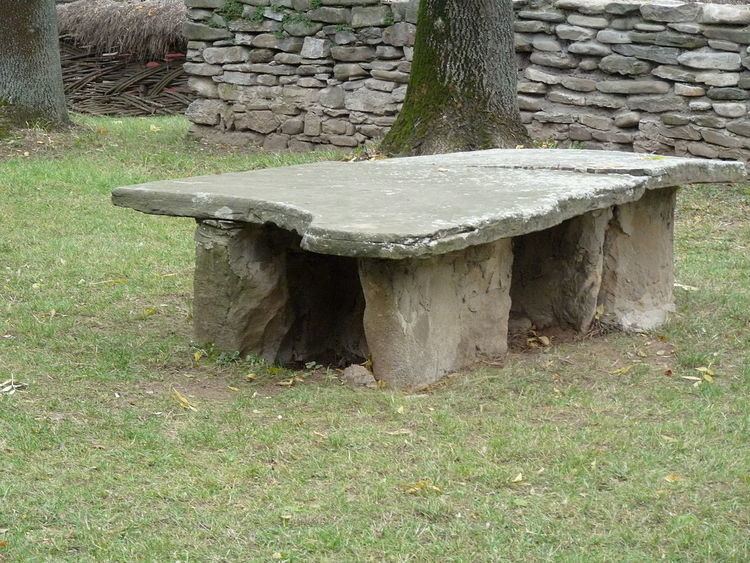 | ||
A stone slab is a big stone, flat and of little thickness, that are generally used for paving floors, for covering walls or as headstones.
Contents
- Slabs used in dolmens
- Slabs in the construction
- Slabs in the gastronomy
- Grave slabs
- Slab washboards
- Slabs as hunting traps
- The term slab in toponyms
- References
Other definitions refine the meaning a bit more:
Slabs used in dolmens
Most dolmen constructions they were built using stone slabs of big dimensions. Their architecture often includes a corridor of access that can be constructed usins stone slabs or dry stones. The burial chamber, with variable shapes (rectangular, polygonal, oval, circular ...) can also be preceded by an anteroom. In some dolmens, the entrance has a door cut into one or more vertical stone slabs.
Slabs in the construction
The main applications of the slabs as material of construction are for pavings and in the construction of roofs. But they can be employed for other uses, among them:
Slabs in the gastronomy
A system to cook the foods is “to the slab”. In like manner to the systems of “to the iron” or “grilled”, in the procedure to bake to the slab the foods course (meat, fish, vegetables,...) They put on a slab hot on of the fire. With oil, butter or lard and all the aditaments with that want to dress the teak.
Grave slabs
From prehistoric times there are examples of graves covered with a stone slab, in its natural state or carved. This use as tombstone has extended the concept of natural slab to the tombstone variant: flat, thin and polished. Example: the slab in the tomb of King Pere el Gran of Aragon, with a weight of 900 kg.
The tombstones use to have some inscriptions. The information on the stone slab traditionally includes the name of the deceased and his date of birth and death. The inscriptions are generally in the frontal side of the stone slab but also in some cases in the verso and around the edges of the slab, some families request to write an inscription in the unseen part of the stone slab (oriented to the ground). Apart from the name, some slabs also have epitaphs in praise of the deceased or citations of religious texts, as "Requiescat in pace".
Slab washboards
Wash the clothes is a basic need in the societies civilised and, in general, in all the parts of the world. In primitive periods - before the running water, the washing machines and the detergents- it was necessary to go to wash the clothes to the river bank or in a laundry room
The clothes washed manually, with soap needed some rubbing and sometimes striking them against a hard surface. The aim was to do penetrate the mix of water and soap between the fibres of the fabric to pull-out the dirt. The slabs to wash the clothes were slabs of natural stone chosen to present a fine and relatively flat surface. The small rounded irregularities could help of friction in the washing process.
Slabs as hunting traps
Hunt with slab is a system to hunting by means of a slab-trap. The fundamental part of the device is a slab. Preparing this trap was a delicate task.
The term "slab" in toponyms
From the term slab and his derivatives there are a big quantity of toponyms among them.
